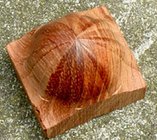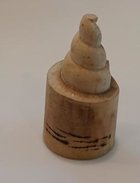It does appear that there is less actual human interaction at the “tool meeting the wood” in the scenario of CNC manufactured goods. As for the sci-fi fantasy…. Not my field of expertiseMany si-fi / distopia also posit that the computer is sentient and decides on its own what to do. Humans are never involved.
-
We just finished moving the forums to a new hosting server. It looks like everything is functioning correctly but if you find a problem please report it in the Forum Technical Support Forum (click here) or email us at forum_moderator AT aawforum.org. Thanks! -
Beware of Counterfeit Woodturning Tools (click here for details) -
Johnathan Silwones is starting a new AAW chapter, Southern Alleghenies Woodturners, in Johnstown, PA. (click here for details) -
Congratulations to Dave Roberts for "2 Hats" being selected as Turning of the Week for April 22, 2024 (click here for details) -
Welcome new registering member. Your username must be your real First and Last name (for example: John Doe). "Screen names" and "handles" are not allowed and your registration will be deleted if you don't use your real name. Also, do not use all caps nor all lower case.
You are using an out of date browser. It may not display this or other websites correctly.
You should upgrade or use an alternative browser.
You should upgrade or use an alternative browser.
"seeing" the curve
- Thread starter odie
- Start date
That is not my experience at all. The work is programmed as best can be done to take advantage of grain, same as a hand turner will do.the grain direction in bowl turning is something only a human can deal with.....and end up with the perfect cut without the need for aggressive sanding
The end grain is not a major issue because of the type cutting tool used. The insert pictured here is very close to what I use in the CNC lathe. 35 degree diamond insert with a .016" nose radius, high positive rake, mirror polished and razor sharp. The manufacturers are not joking when they say be careful, these truly are razor sharp.
As I've said a number of times these are not inserts that could be used in a hand held tool. They're aggressive and tend to self feed into the work if not rigidly mounted as in a CNC or other automated turning machine.
Where the grain direction issue can't be avoided, you slice right through it. Think about it, you have such a small nose contact radius doing the cutting, small enough that it tends to sever wood fibers rather than pushing them out of the way which might leave a rough surface.
The lathe also has CS (constant surface speed) meaning the spindle increases rpm's on small diameters and decreases at the outer large diameter to maintain optimum cutting conditions.
Very little sanding is needed using the insert shown. Mostly just enough to remove fuzz.
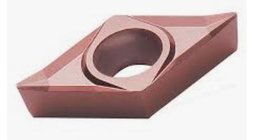
Here's a kiln dried shallow red oak bowl in progress, 6" diameter. Wall thickness at rim is about .065" at all positions. This in itself is an indications of the tool or the rim not being pushed away in the tougher areas. The un-sanded inside has a very slightly noticeable roughness at 3 and 9 o'clock positions. The bottom was a trial of wipe on acrylic and a quick touch of 320 paper to remove color from high spots of grain. No feel of grain at all on the bottom.
The harder the wood the better job the machine does.
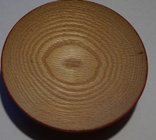
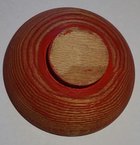
Again, this is my experience.......
Last edited:
odie
TOTW Team
- Joined
- Dec 22, 2006
- Messages
- 7,116
- Likes
- 9,830
Again, this is my experience.......
Again, your experience has not been my experience.
Here's a challenge, Doug:
Instead of showing us some bowls with very simple shapes, show us some examples of CNC turned bowls with intricate shapes.
Sort of like this, with an undercut rim, among other advanced shapes:
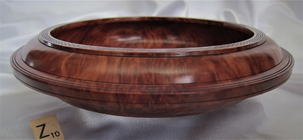
Or this:
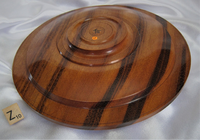
Click on my AAW gallery, and you'll see I'm doing these things with regularity, and it's all hand turned using very old methods with old style tools that have been long out of fashion for turners. The only real significant difference I've been aware of is there is something called "spiritual turning", which has not been reproduced by modern high tech methods.....because of that, I've never seen CNC lathe turned bowls that have this same capability by eliminating the human element.....all for the reasons I've been stressing in this thread.
Here's a question: If CNC has the capability to produce bowls of the quality you've been expressing, where are they?.....and, why hasn't CNC surpassed, and made handmade bowl turning obsolete?
I ran a search for CNC turned bowls, and what do you know?.....one of my own bowls came up in that search!
-----odie-----
Last edited:
That's a good question Odie. There're a few reasons I can think of quickly, but I certainly can't answer for those who are opposed to CNC .Here's a question: If CNC has the capability to produce bowls of the quality you've been expressing, where are they?.....and, why hasn't CNC surpassed, and overcome handmade bowl turning?
1) It's too expensive. Probably was a valid reason in years past. Lately with the offshore imports you could equip yourself with a CNC router for much less than a high end wood lathe. A CNC router can do everything a CNC lathe can and more, but the cut quality for basic bowl "turning" won't equal the CNC lathe primarily because the rotating cutters usually can't match the cutting of lathes.
2) The turner feels he's too old to learn. This the one I hear the most. Young kids jump right into CNC, but they're learning CNC basics, coding, in the 5th grade now.
3) The AAW doesn't promote CNC's. Combine that with the mis-information provided by some.
4) Some people enjoy hand turning and have no interest in CNC. That's great, more power to them if they enjoy hand turning.
5) Change is difficult.
odie
TOTW Team
- Joined
- Dec 22, 2006
- Messages
- 7,116
- Likes
- 9,830
That's a good question Odie. There're a few reasons I can think of quickly, but I certainly can't answer for those who are opposed to CNC .
1) It's too expensive. Probably was a valid reason in years past. Lately with the offshore imports you could equip yourself with a CNC router for much less than a high end wood lathe. A CNC router can do everything a CNC lathe can and more, but the cut quality for basic bowl "turning" won't equal the CNC lathe primarily because the rotating cutters usually can't match the cutting of lathes.
2) The turner feels he's too old to learn. This the one I hear the most. Young kids jump right into CNC, but they're learning CNC basics, coding, in the 5th grade now.
3) The AAW doesn't promote CNC's. Combine that with the mis-information provided by some.
4) Some people enjoy hand turning and have no interest in CNC. That's great, more power to them if they enjoy hand turning.
5) Change is difficult.
Or......another possibility could be...
CNC just doesn't work like some people believe it should when comparing it with what is possible while keeping the human input in the process. I think some people are having a difficult time believing that technology has not come to the point where it can overcome the advantages a thinking human being has. There is not much thinking involved in baseball bats, or staircase spindles......but, cross grain bowls present problems that only a thinking person can overcome.
I can understand why some turners don't have the resources to have a CNC, but you would think a few would have the resources, and have tried it, at least. If that were so, we might have heard about it......that is, if they were successful with cross grain bowl turning beyond a very basic bowl using very specific less problematic woods. If they were not successful with difficult shapes using difficult woods, we might not hear volumes of information about the failures.
-----odie-----
Doug - good list of reasons....just not good reasons - So I thought about your list, and want to make one last attempt to help you see why I believe that there is a distinct difference between CNC/machine made vs manualized works produced by humans and a simple lathe. I wish NOT to argue with you. I am only tryin to explain why I think you may not recognize as the intangible qualities of hand-turned vs CNC.
- So I thought about your list, and want to make one last attempt to help you see why I believe that there is a distinct difference between CNC/machine made vs manualized works produced by humans and a simple lathe. I wish NOT to argue with you. I am only tryin to explain why I think you may not recognize as the intangible qualities of hand-turned vs CNC.
1) It's too expensive. Probably was a valid reason in years past. Lately with the offshore imports you could equip yourself with a CNC router for much less than a high end wood lathe. A CNC router can do everything a CNC lathe can and more, but the cut quality for basic bowl "turning" won't equal the CNC lathe primarily because the rotating cutters usually can't match the cutting of lathes. I don't see it this way - and believe that this is not the case for others. The amount of money I have wasted on other hobbies is considerably more than what we are talking about here.
2) The turner feels he's too old to learn. This the one I hear the most. Young kids jump right into CNC, but they're learning CNC basics, coding, in the 5th grade now.
Nope.....woodturning is a continual learning process. SO the mindset of successful turners will always be "pro" continuing education. In fact - the average age of the AAW membership is 72. Check the data. Many "professional" turners earn most of their income via teaching these AAW members.
3) The AAW doesn't promote CNC's. Combine that with the mis-information provided by some. Exactly. WHY would an organization that promotes artistic creativity - shift to promoting computer driven machinery that replaces a great deal of what it upholds and awards humans for??? Just thumb thru a few issues of the AAW magazine- and think about the detail, effort, and imagination that you see pictured therein. It is not possible for many - rather- most -...o.k. - almost everything that is held up for the world to see what the mind, the hands, and and the heart - as the seat of emotion - are conveying thru the textured, painted or stained, or mega-segmented works that are work product of someone's soul.
4) Some people enjoy hand turning and have no interest in CNC. That's great, more power to them if they enjoy hand turning.
If one is shopping for a painting - and not a print, they are seeking a connection with the artist. To know that the given artist has expressed their thoughts and emotions via a brush held in their hand - directed by the artist's mind, imagination, heart and soul. THAT is what turning by hand strives for. That is spiritual turning.
To the same person that is shopping for the painting - a print does not have the same connection to the artist. Just as a photograph of a person is not the same as the physical presence of that person. Yet my camera gear is amazing technologically - and can produce pictures many many times faster than I could ever draw or paint.
So, I think the difference is - what do you value? The speed and ease of computer driven machinery, capable of multiple copies of 1 original product? Or 1 original product which would be extraordinarily difficult - if not impossible to replicate.
5) Change is difficult. This is such a broad and over simplified statement that it cannot even be offensive to anyone. For some - changing their socks may be difficult. Others, changing the color of paint on their house. So what? I think that Sure - there are always individuals that hate change. But the majority are constantly in awe of seeing the possibilities of human creativity. even with what can be done with advanced machinery and computers. But don't let that confuse the issue here: Even in cases of "change" without any degree of difficulty....many- (and I will say the vast majority) of the woodturning world will always prefer to define true artistic endeavor as that which is determined by the intimate connection of the human artisan, holding a tool, and directing said tool via what he sees in his mind's eye. That requires imagination and feeling........CNC cannot convey that combination of emotion and independence from logic required to define true creativity. It can copy, and re-produce wonderfully from what I see....
For some - changing their socks may be difficult. Others, changing the color of paint on their house. So what? I think that Sure - there are always individuals that hate change. But the majority are constantly in awe of seeing the possibilities of human creativity. even with what can be done with advanced machinery and computers. But don't let that confuse the issue here: Even in cases of "change" without any degree of difficulty....many- (and I will say the vast majority) of the woodturning world will always prefer to define true artistic endeavor as that which is determined by the intimate connection of the human artisan, holding a tool, and directing said tool via what he sees in his mind's eye. That requires imagination and feeling........CNC cannot convey that combination of emotion and independence from logic required to define true creativity. It can copy, and re-produce wonderfully from what I see....
I wish no ill feelings - but have delivered this vomitous diatribe in an attempt to simplify the intangible differences between hands-on woodturning vs CNC or other machinery derived methods.
Best to all - and have a happy and safe holiday-
T
1) It's too expensive. Probably was a valid reason in years past. Lately with the offshore imports you could equip yourself with a CNC router for much less than a high end wood lathe. A CNC router can do everything a CNC lathe can and more, but the cut quality for basic bowl "turning" won't equal the CNC lathe primarily because the rotating cutters usually can't match the cutting of lathes. I don't see it this way - and believe that this is not the case for others. The amount of money I have wasted on other hobbies is considerably more than what we are talking about here.
2) The turner feels he's too old to learn. This the one I hear the most. Young kids jump right into CNC, but they're learning CNC basics, coding, in the 5th grade now.
Nope.....woodturning is a continual learning process. SO the mindset of successful turners will always be "pro" continuing education. In fact - the average age of the AAW membership is 72. Check the data. Many "professional" turners earn most of their income via teaching these AAW members.
3) The AAW doesn't promote CNC's. Combine that with the mis-information provided by some. Exactly. WHY would an organization that promotes artistic creativity - shift to promoting computer driven machinery that replaces a great deal of what it upholds and awards humans for??? Just thumb thru a few issues of the AAW magazine- and think about the detail, effort, and imagination that you see pictured therein. It is not possible for many - rather- most -...o.k. - almost everything that is held up for the world to see what the mind, the hands, and and the heart - as the seat of emotion - are conveying thru the textured, painted or stained, or mega-segmented works that are work product of someone's soul.
4) Some people enjoy hand turning and have no interest in CNC. That's great, more power to them if they enjoy hand turning.
If one is shopping for a painting - and not a print, they are seeking a connection with the artist. To know that the given artist has expressed their thoughts and emotions via a brush held in their hand - directed by the artist's mind, imagination, heart and soul. THAT is what turning by hand strives for. That is spiritual turning.
To the same person that is shopping for the painting - a print does not have the same connection to the artist. Just as a photograph of a person is not the same as the physical presence of that person. Yet my camera gear is amazing technologically - and can produce pictures many many times faster than I could ever draw or paint.
So, I think the difference is - what do you value? The speed and ease of computer driven machinery, capable of multiple copies of 1 original product? Or 1 original product which would be extraordinarily difficult - if not impossible to replicate.
5) Change is difficult. This is such a broad and over simplified statement that it cannot even be offensive to anyone.
I wish no ill feelings - but have delivered this vomitous diatribe in an attempt to simplify the intangible differences between hands-on woodturning vs CNC or other machinery derived methods.
Best to all - and have a happy and safe holiday-
T
- Joined
- Apr 27, 2004
- Messages
- 8,641
- Likes
- 4,979
- Location
- Lakeland, Florida
- Website
- www.hockenberywoodturning.com
The AAW doesn't promote CNC's. Combine that with the mis-information provided by some.
Why would it? The AAW is going to be pretty neutral unless a lathe is involved.
The W is Woodturning not Woodart.
The AAW is quite inclusive in presenting technology used on wood before it goes on the lathe, while it is on the lathe, and after it comes off the lathe. There are lots of articles and demos put on by the AAW using machines to assist in turning or in modifying turned objects. Ornamental turning, using routers on turning, all sorts of carving machines, sanding machines, laser machines, sanding machines, saws…….
People are making soft jaws for chucks on CNCs - that could be an article in the Journal.
Sometimes the AAW stretches into wood art that doesn’t involve turning …. Work by Michael Peterson, Christian Burchard are two that come to mind who have had photos of non turned work in the journal.
Also remember a symposium demo on bowls made by gluing stacks of irregularly cut bandsaw sections and then refine the surface with abrasives no lathe involved.
Making a round wooden object on a CNC is not Woodturning. It may well be wood art.
I used a machine to cut the resist to sand carve these patterns.
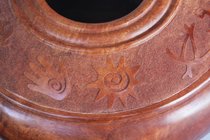 .
. 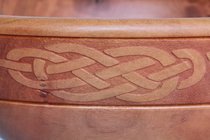
A CNC could relief carve these patterns
A laser could etch these patterns
A person could carve,stipple or pyrography these patterns
Last edited:
odie
TOTW Team
- Joined
- Dec 22, 2006
- Messages
- 7,116
- Likes
- 9,830
Hello Al......While a CNC could create patterns like that, the whole crux of the discussion here, is turning with CNC. I would agree that there are some things a CNC can do that are truly outstanding, and there is value in the realm of "art", but they do not appear to be within the act of turning.
-----odie-----
odie
TOTW Team
- Joined
- Dec 22, 2006
- Messages
- 7,116
- Likes
- 9,830
If one is shopping for a painting - and not a print, they are seeking a connection with the artist. To know that the given artist has expressed their thoughts and emotions via a brush held in their hand - directed by the artist's mind, imagination, heart and soul.
the majority are constantly in awe of seeing the possibilities of human creativity. even with what can be done with advanced machinery and computers. But don't let that confuse the issue here: Even in cases of "change" without any degree of difficulty....many- (and I will say the vast majority) of the woodturning world will always prefer to define true artistic endeavor as that which is determined by the intimate connection of the human artisan
While these quotes may not directly involve the current discussion, I found them to be important ones nonetheless.....and both gave me pause.
Thanks.
-----odie-----
Last edited:
- Joined
- Apr 27, 2004
- Messages
- 8,641
- Likes
- 4,979
- Location
- Lakeland, Florida
- Website
- www.hockenberywoodturning.com
There are two relevant uses of technologiesHello Al......While a CNC could create patterns like that, the whole crux of the discussion here, is turning with CNC. I would agree that there are some things a CNC can do that are truly outstanding, and there is value in the realm of "art", but they do not appear to be within the act of turning.
-----odie-----
1. An alternative method to turning:
CNC and Digital Printing - both can make objects that look like they were turned.
These object have nothing to do with turning
2. Using the technology in conjunction with turning
However technology CNC and digital printing can be used
Both can make tools that can be used in turning
Both can make blanks to be turned
Both can be used change or add elements to turnings.
odie
TOTW Team
- Joined
- Dec 22, 2006
- Messages
- 7,116
- Likes
- 9,830
There are two relevant uses of technologies
1. An alternative method to turning:
CNC and Digital Printing - both can make objects that look like they were turned.
These object have nothing to do with turning
2. Using the technology in conjunction with turning
However technology CNC and digital printing can be used
Both can make tools that can be used in turning
Both can make blanks to be turned
Both can be used change or add elements to turnings.
This discussion is taking some twists and turns that are worthy of exploration.
There is a point Tim made that is applicable, and that is: At what point is the value of art is diminished, when the viewer's connection to the artist is lessened by the introduction of technology?
If one is shopping for a painting - and not a print, they are seeking a connection with the artist. To know that the given artist has expressed their thoughts and emotions via a brush held in their hand - directed by the artist's mind, imagination, heart and soul. THAT is what turning by hand strives for. That is spiritual turning.
To the same person that is shopping for the painting - a print does not have the same connection to the artist. Just as a photograph of a person is not the same as the physical presence of that person. Yet my camera gear is amazing technologically - and can produce pictures many many times faster than I could ever draw or paint.
So, I think the difference is - what do you value?
What I value, what Al values, and what Tim values......may have overlaps, but have different core concepts!
-----odie-----
Last edited:
I see two separate facets to this discussion:
1. Making the object
2. Evaluating the object
Making - Human vs machine
IMO this is akin to playing a video game of football vs being a participant in the game. Having done some of the former and a lot of the latter, they are distinctly different and performance is not to be judged comparatively. While both require mental participation, those requirements are vastly different. Physically, one requires manipulation of the thumbs and a finger or 2, the other total body immersion in training and execution. Having spent 35 yrs working with programmable machines and ~10 years turning, IMO there are vastly different and shouldn't be compared, for much the same reason.
Evaluation - Human vs 100% machine made
I think the video vs real football analogy carries over. How does watching a digital representation of a football game vs a real game played by humans grab your attention? Do you hold any reverence for the programmer(s) that "played" the game? What about a great human game? Any reverence for great performances or strategies, obstacles overcome, the real time struggles of humans to achieve a goal?
Another analogy - supposed reality tv. All kinds of tv shows drummed up over the years supposedly showing the "real time" struggles of ice road truckers, living in Alaska, mining for gold, etc - the only reality being that all of them are staged or "programmed". Sports, on the other hand, are real, live, in the moment, reality (except boxing and the '19 Black Sox).
One may value the results of the "programmed" object, but it's a completely different skill set that is being valued vs the human turned item. I value items that are turned on the lathe and then almost all surfaces carved or otherwise changed to become something else in the same way - I see great carving ability, but it tells me nothing of their turning ability, and thus should not be evaluated with the same perspective. Does one compare artistic photography directly against artistic paintings?
1. Making the object
2. Evaluating the object
Making - Human vs machine
IMO this is akin to playing a video game of football vs being a participant in the game. Having done some of the former and a lot of the latter, they are distinctly different and performance is not to be judged comparatively. While both require mental participation, those requirements are vastly different. Physically, one requires manipulation of the thumbs and a finger or 2, the other total body immersion in training and execution. Having spent 35 yrs working with programmable machines and ~10 years turning, IMO there are vastly different and shouldn't be compared, for much the same reason.
Evaluation - Human vs 100% machine made
I think the video vs real football analogy carries over. How does watching a digital representation of a football game vs a real game played by humans grab your attention? Do you hold any reverence for the programmer(s) that "played" the game? What about a great human game? Any reverence for great performances or strategies, obstacles overcome, the real time struggles of humans to achieve a goal?
Another analogy - supposed reality tv. All kinds of tv shows drummed up over the years supposedly showing the "real time" struggles of ice road truckers, living in Alaska, mining for gold, etc - the only reality being that all of them are staged or "programmed". Sports, on the other hand, are real, live, in the moment, reality (except boxing and the '19 Black Sox).
One may value the results of the "programmed" object, but it's a completely different skill set that is being valued vs the human turned item. I value items that are turned on the lathe and then almost all surfaces carved or otherwise changed to become something else in the same way - I see great carving ability, but it tells me nothing of their turning ability, and thus should not be evaluated with the same perspective. Does one compare artistic photography directly against artistic paintings?
Odie-
This statement: "At what point is the value of art is diminished, when the viewer's connection to the artist is lessened by the introduction of technology?" Is a part of my point...but maybe I was remiss in expressing the value of the artist being lessened as well.
In the age of rapidly changing/expanding technology...at what point is the value of artist created art diminished to the point of no value? How do we define artist created art if we continue to allow the influence of machinery and computers to lessen the importance of the human hand, mind and spirit...what are we left with?
And - for the record....my training, education and working knowledge are anything but Luddite in nature. I am NOT anti-technology. But I also understand that is not the answer for every need. We must recognize the value of the personal connections that make humanity superior to technology. Even with our flaws - and the flaws in our work.
This statement: "At what point is the value of art is diminished, when the viewer's connection to the artist is lessened by the introduction of technology?" Is a part of my point...but maybe I was remiss in expressing the value of the artist being lessened as well.
In the age of rapidly changing/expanding technology...at what point is the value of artist created art diminished to the point of no value? How do we define artist created art if we continue to allow the influence of machinery and computers to lessen the importance of the human hand, mind and spirit...what are we left with?
And - for the record....my training, education and working knowledge are anything but Luddite in nature. I am NOT anti-technology. But I also understand that is not the answer for every need. We must recognize the value of the personal connections that make humanity superior to technology. Even with our flaws - and the flaws in our work.
Last edited:
odie
TOTW Team
- Joined
- Dec 22, 2006
- Messages
- 7,116
- Likes
- 9,830
I was turning last evening around midnight, and was thinking about "seeing the curve". Unfortunately, not all of us are equal, in the quest to see the curve. In my own self evaluation, I see myself as maybe a basic 7 or 8, on a scale of one to ten for seeing the curve. If I've had any advantage, it's related to repetition, over and over and over again.....over many years. Seeing the curve is something you cultivate with practice. One thing of importance, is to practice getting the perfect curve, even when it won't be the final surface. In bowl turning, at the roughing stage, and the initial stages of the final turning, there is great opportunity to engineer a perfect curve repeatedly. Taking advantage of the opportunity means it increases the time it takes to complete the bowl, and some might confuse it with wasted effort.....but, it's a self-improvement opportunity taken advantage of......or missed!
So.....take advantage of it!
(Unless, of course.....you think you're perfect! )
)
-----odie-----
So.....take advantage of it!
(Unless, of course.....you think you're perfect!
-----odie-----
Since only my dog brlieves I am perfect…. Practice it is!
The "picked up and fondled" part ... I said that to the -mosty female- cardiac therapists I see and they went wild ! And most added something about "wood" too. Aah, what we old folks have to endure sometimes.
-Now back to your regular programming.
-Mike (a.k.s. MPart)
-Now back to your regular programming.
-Mike (a.k.s. MPart)
Odie wrote: "there is great opportunity to engineer a perfect curve repeatedly"
I've never understood what you meant by a "perfect curve". But, it just occurred to me maybe you mean a profile where the various elements making up the profile are tangential. Having tangential elements seems to be a necessity in pleasing profiles. An ogee would be a curve that suffers unless the elements have a smooth transition, in other words being tangent at their point of intersection.
I've never understood what you meant by a "perfect curve". But, it just occurred to me maybe you mean a profile where the various elements making up the profile are tangential. Having tangential elements seems to be a necessity in pleasing profiles. An ogee would be a curve that suffers unless the elements have a smooth transition, in other words being tangent at their point of intersection.
A sweet curve is like pornography - I know it when I see it. Smooth transitions are necessary but not sufficient.
A “perfect curve” cannot be boiled down to the mechanical kind of mathmatics. It is something that evokes one to be drwan to look at and maybe even follow it with your hand.
odie
TOTW Team
- Joined
- Dec 22, 2006
- Messages
- 7,116
- Likes
- 9,830
A sweet curve is like pornography - I know it when I see it. Smooth transitions are necessary but not sufficient.
A “perfect curve” cannot be boiled down to the mechanical kind of mathmatics. It is something that evokes one to be drwan to look at and maybe even follow it with your hand.
Well....yes and yes!
(From my POV, Kevin has the most perfect answer....."He knows it when he sees it" is a profound and fitting explanation, because it has something to do with the subconscious level of evaluation.)
The perfect curve can probably have as many definitions as those who are attempting to define it. The definition can be on an intellectual level, or it can be on a sensual level. If we use geometry to describe the perfect curve, then that would tend to be on the intellectual level....and, mathematically calculable.
Another kind of perfect curve is that which converts what you see with your eyes, into a subconscious sensual experience.
For instance, suppose you are observing the profiles of two vases. One may stand out over the other, but there seems to be no rational explanation for it.....other than one just tweaks your aesthetic sensibilities more than the other. That which draws you to the best profile, is a subconscious satisfaction that resonates from somewhere within the soul.....rather than a brainy deduction.
More on this subject can be read in my first post in this thread...
-----odie-----
We live in a time that in many cases - wants to draw closer the Arts - and Sciences - into a confusing, bewildering gumbo. Fine....I get it -and I am amazed daily at "what a machine can now accomplish " . Please note - accomplish not invent, not create, not dream up.....
Because - hopefully those are the areas of humanity which will continue to separate us from the machines as machines continue be invented to do more, and more things.
For as long as man is considered superior to, and the creator of machines- ....man - with his own mind, heart, soul and HANDS......will be the artist. NOT the machines he chooses to use. Even if a machine is invented that can mimic the artist's work.....
Perhaps the one thing that shall always separate man from machine - as the creator of art - is that machines cannot feel inspiration. Machines are great for production...but not origination and creation.
Because - hopefully those are the areas of humanity which will continue to separate us from the machines as machines continue be invented to do more, and more things.
For as long as man is considered superior to, and the creator of machines- ....man - with his own mind, heart, soul and HANDS......will be the artist. NOT the machines he chooses to use. Even if a machine is invented that can mimic the artist's work.....
Perhaps the one thing that shall always separate man from machine - as the creator of art - is that machines cannot feel inspiration. Machines are great for production...but not origination and creation.
What a great discussion. It’s like the rule of 3rds in photography. Brining the focal point to one of the intersections. People may not know why their eye is drawn to those intersections but it really works versus say, putting a subject dead center in a photograph.
Let me slightly alter your statement to express my opinion.I am amazed daily at "what a machine can now accomplish " . Please note - accomplish not invent, not create, not dream up.....
Please note - machines allow me to accomplish my inventions, my creations and my dreams.
It may be in our genes. In Googling on subjects related to "pleasing forms" I came across one study linking what pleases the eye to back when we were hunter gatherers. The most pleasing form was a plump animal as opposed to a scrawny one.That which draws you to the best profile, is a subconscious satisfaction that resonates from somewhere within the soul.....rather than a brainy deduction.
No argument there Doug! - I think for me - the line in the sand is not what machines can do. It is what they cannot. They cannot replace the innovation and imagination of us, as the people that have those dreams.Let me slightly alter your statement to express my opinion.
Please note - machines allow me to accomplish my inventions, my creations and my dreams.
True...and I think that the "spiritual" part of what Odie is pointing to - is.....a more ethereal thing that is not as simple as a calculable ratio or formulae. It is more along the lines of why we often will stand and look at a painting or sculpture and struggle to verbalize the..."IT".....that this particular piece captures and captivates our attention with.What a great discussion. It’s like the rule of 3rds in photography. Brining the focal point to one of the intersections. People may not know why their eye is drawn to those intersections but it really works versus say, putting a subject dead center in a photograph.
Lest ye forget - it took human innovation, imagination, and dreams to step by step create the machines you discuss over a few hundred years. Point is, even when AI gets to the point of “thought” (dont know that it can happen), humans created all of it, many of those machines being “art”. The art originates within humans, even if it is programmed.
You touched on something that I think deserves - yet another -Lest ye forget - it took human innovation, imagination, and dreams to step by step create the machines you discuss over a few hundred years. Point is, even when AI gets to the point of “thought” (dont know that it can happen), humans created all of it, many of those machines being “art”. The art originates within humans, even if it is programmed.
Artist, craftsman, or manufacturer.
As a turner, a lover of the wood and what I’m able to transform it into. I love the craft. All of those things we need to study and most importantly, practice, over and over. From chainsaw skills, to understanding our media, how it moves, why it cracks, to skill in sharpening and handling our tools, especially when discussing our gouges. What a fascinating tool. So simple, but also so complicated and wonderful. The huge variety of cuts and scrapes. Everything from huge roughing cuts to the most delicate of curves achieved with this one tool. Learning our processes is so similar to learning a musical instrument.
The goal, as far a craftsmanship is to gain the proficiency needed such that when I think wood should be removed here or there, or that curve needs to be adjusted, that my hands know mostly what to do, leaving me free to concentrate on the subtleties of this particular cut.
Then there is the whole design thing. Fortunately for me, the artistic design has limits. I mean, it’s a bowl, right? Probably round- probably has a rim of some sort and a foot (or not). We need to connect the top to the bottom in a graceful fashion. Obviously much more complicated in practice.
There is a whole mind, heart, and body thing going on. That’s the great stuff.
I’m sure the CNC can produce a lovely piece, and can make 99 more of them, each one as lovely as the first. But that’s manufacturing, isn’t it?
Granted, an artist (or math wiz) designs the profile. And a skilled operator to input to the machine. But then it’s a manufacturing process.
I believe the comparison was made to a painting vs a print of that painting (or 100 prints, each identical to the original).
As a turner, a lover of the wood and what I’m able to transform it into. I love the craft. All of those things we need to study and most importantly, practice, over and over. From chainsaw skills, to understanding our media, how it moves, why it cracks, to skill in sharpening and handling our tools, especially when discussing our gouges. What a fascinating tool. So simple, but also so complicated and wonderful. The huge variety of cuts and scrapes. Everything from huge roughing cuts to the most delicate of curves achieved with this one tool. Learning our processes is so similar to learning a musical instrument.
The goal, as far a craftsmanship is to gain the proficiency needed such that when I think wood should be removed here or there, or that curve needs to be adjusted, that my hands know mostly what to do, leaving me free to concentrate on the subtleties of this particular cut.
Then there is the whole design thing. Fortunately for me, the artistic design has limits. I mean, it’s a bowl, right? Probably round- probably has a rim of some sort and a foot (or not). We need to connect the top to the bottom in a graceful fashion. Obviously much more complicated in practice.
There is a whole mind, heart, and body thing going on. That’s the great stuff.
I’m sure the CNC can produce a lovely piece, and can make 99 more of them, each one as lovely as the first. But that’s manufacturing, isn’t it?
Granted, an artist (or math wiz) designs the profile. And a skilled operator to input to the machine. But then it’s a manufacturing process.
I believe the comparison was made to a painting vs a print of that painting (or 100 prints, each identical to the original).
odie
TOTW Team
- Joined
- Dec 22, 2006
- Messages
- 7,116
- Likes
- 9,830
Artist, craftsman, or manufacturer.
As a turner, a lover of the wood and what I’m able to transform it into. I love the craft. All of those things we need to study and most importantly, practice, over and over. From chainsaw skills, to understanding our media, how it moves, why it cracks, to skill in sharpening and handling our tools, especially when discussing our gouges. What a fascinating tool. So simple, but also so complicated and wonderful. The huge variety of cuts and scrapes. Everything from huge roughing cuts to the most delicate of curves achieved with this one tool. Learning our processes is so similar to learning a musical instrument.
The goal, as far a craftsmanship is to gain the proficiency needed such that when I think wood should be removed here or there, or that curve needs to be adjusted, that my hands know mostly what to do, leaving me free to concentrate on the subtleties of this particular cut.
Then there is the whole design thing. Fortunately for me, the artistic design has limits. I mean, it’s a bowl, right? Probably round- probably has a rim of some sort and a foot (or not). We need to connect the top to the bottom in a graceful fashion. Obviously much more complicated in practice.
There is a whole mind, heart, and body thing going on. That’s the great stuff.
I’m sure the CNC can produce a lovely piece, and can make 99 more of them, each one as lovely as the first. But that’s manufacturing, isn’t it?
Granted, an artist (or math wiz) designs the profile. And a skilled operator to input to the machine. But then it’s a manufacturing process.
I believe the comparison was made to a painting vs a print of that painting (or 100 prints, each identical to the original).
There are several great points, and considerations to ponder here.....
Thanks for your post, Marc.....
-----odie-----
I’m sure the CNC can produce a lovely piece, and can make 99 more of them, each one as lovely as the first. But that’s manufacturing, isn’t it?
Granted, an artist (or math wiz) designs the profile. And a skilled operator to input to the machine. But then it’s a manufacturing process.
Uh.... the CNC lathe can't produce anything. It's a tool, just like a Hunter carbide insert gouge. They're both tools like so many other tools a turner controls in producing his/her work.
You seem to be implying once the CNC turner makes one good piece to his satisfaction it's simply a matter of hitting the cycle start button 99 times to produce more identical pieces. Think about it.... wood is not a homogeneous material. If you were to hand turn 100 identical pieces you would vary the technique on each piece to take advantage of the grain and other characteristics of each particular piece of wood. Same exact thing with a CNC , I program to the wood's characteristics (especially carefully on rare or valuable wood). Call that "manufacturing" if you want.
The biggest advantage of using a CNC lathe in woodturning is the ability to use fine pointed tools like a 35 degree high positive diamond insert with a tiny nose radius. No hand turner, no matter how experienced, can match that cut. Sanding is minimal if at all. Plus, no worry about sharpening or what style gouge or grind; Say goodbye to the possibility of a catch unless the workpiece comes loose.
odie
TOTW Team
- Joined
- Dec 22, 2006
- Messages
- 7,116
- Likes
- 9,830
The biggest advantage of using a CNC lathe in woodturning is the ability to use fine pointed tools like a 35 degree high positive diamond insert with a tiny nose radius. No hand turner, no matter how experienced, can match that cut.
I beg to differ......I not only can match that cut, I can get a better cleaner cut. With me, the difference is my lathe turning is a sensual experience, where multiple senses are in coordination......while CNC is strictly mechanical.
Doug.....I refer you to post #123. In that post, my challenge to you, and the final question still stands.
If a CNC can lathe turn the details like a human can.......then show us some examples of intricately turned CNC turned bowls that prove what you say.
Here's a question: If CNC has the capability to produce bowls of the quality you've been expressing, where are they?.....and, why hasn't CNC surpassed, and made handmade bowl turning obsolete?
-----odie-----
Last edited:
Odie,
First off I don't have any intricately turned bowls. Not because I can't do them, just not interested in doing them. The bowls I have are "form follows function" type. I will see what I have that could be equivalent or maybe I'll do some. It won't happen immediately though. I'm busy right now finished up our new house. Sounds like a lame excuse huh? But I have a lot to do before winter hits and our unusually hot weather isn't making exterior work any easier.
One point I want to make is the lathe cutting tool I use has become an industry standard in automated turning. Google on "CNC woodturning" or look at related Youtube videos on that subject. There's a reason that tool is used where sanding in production turning is not practical. It's a cutter that can both hog large amounts of material and still be capable of intricate detailing. Show me a hand turning tool that'll do that. Under programmed feed rate control getting down into a few thousands per revolution the very small nose radius can produce a surface smooth to the eye and to the touch.
Your question about why hasn't CNC surpassed, and made handmade bowl turning obsolete.... One good reason is there aren't any CNC wood lathes capable in an affordable price range. You won't find any at Woodcraft or Rockler. You will find CNC routers capable of bowl making. In a previous thread you recall the consensus opinion was even though a CNC router type machine can readily be used in bowl making it doesn't qualify as woodturning. Of the CNC lathes I see on Youtube they are all spindle turning oriented, it may well be that bowl making is so small a market opposed to spindles nobody is interested in building machines for that market. I didn't buy my CNC machines to do woodworking, my business had a prototype machine shop to support our design work. When I sold the business I kept a couple machines.
For the purpose of this discussion if you'll accept "turning like" pieces that were made using a CNC router type machine (metalworking milling machine in my case) that come off the machine with a burnished-like finish needing no sanding I can show lots of those.
First off I don't have any intricately turned bowls. Not because I can't do them, just not interested in doing them. The bowls I have are "form follows function" type. I will see what I have that could be equivalent or maybe I'll do some. It won't happen immediately though. I'm busy right now finished up our new house. Sounds like a lame excuse huh? But I have a lot to do before winter hits and our unusually hot weather isn't making exterior work any easier.
One point I want to make is the lathe cutting tool I use has become an industry standard in automated turning. Google on "CNC woodturning" or look at related Youtube videos on that subject. There's a reason that tool is used where sanding in production turning is not practical. It's a cutter that can both hog large amounts of material and still be capable of intricate detailing. Show me a hand turning tool that'll do that. Under programmed feed rate control getting down into a few thousands per revolution the very small nose radius can produce a surface smooth to the eye and to the touch.
Your question about why hasn't CNC surpassed, and made handmade bowl turning obsolete.... One good reason is there aren't any CNC wood lathes capable in an affordable price range. You won't find any at Woodcraft or Rockler. You will find CNC routers capable of bowl making. In a previous thread you recall the consensus opinion was even though a CNC router type machine can readily be used in bowl making it doesn't qualify as woodturning. Of the CNC lathes I see on Youtube they are all spindle turning oriented, it may well be that bowl making is so small a market opposed to spindles nobody is interested in building machines for that market. I didn't buy my CNC machines to do woodworking, my business had a prototype machine shop to support our design work. When I sold the business I kept a couple machines.
For the purpose of this discussion if you'll accept "turning like" pieces that were made using a CNC router type machine (metalworking milling machine in my case) that come off the machine with a burnished-like finish needing no sanding I can show lots of those.
odie
TOTW Team
- Joined
- Dec 22, 2006
- Messages
- 7,116
- Likes
- 9,830
Odie,
First off I don't have any intricately turned bowls. Not because I can't do them, just not interested in doing them. The bowls I have are "form follows function" type. I will see what I have that could be equivalent or maybe I'll do some. It won't happen immediately though. I'm busy right now finished up our new house. Sounds like a lame excuse huh? But I have a lot to do before winter hits and our unusually hot weather isn't making exterior work any easier.
One point I want to make is the lathe cutting tool I use has become an industry standard in automated turning. Google on "CNC woodturning" or look at related Youtube videos on that subject. There's a reason that tool is used where sanding in production turning is not practical. It's a cutter that can both hog large amounts of material and still be capable of intricate detailing. Show me a hand turning tool that'll do that. Under programmed feed rate control getting down into a few thousands per revolution the very small nose radius can produce a surface smooth to the eye and to the touch.
Your question about why hasn't CNC surpassed, and made handmade bowl turning obsolete.... One good reason is there aren't any CNC wood lathes capable in an affordable price range. You won't find any at Woodcraft or Rockler. You will find CNC routers capable of bowl making. In a previous thread you recall the consensus opinion was even though a CNC router type machine can readily be used in bowl making it doesn't qualify as woodturning. Of the CNC lathes I see on Youtube they are all spindle turning oriented, it may well be that bowl making is so small a market opposed to spindles nobody is interested in building machines for that market. I didn't buy my CNC machines to do woodworking, my business had a prototype machine shop to support our design work. When I sold the business I kept a couple machines.
For the purpose of this discussion if you'll accept "turning like" pieces that were made using a CNC router type machine (metalworking milling machine in my case) that come off the machine with a burnished-like finish needing no sanding I can show lots of those.
OK Doug.....
In other words, there is no proof of your claims.....from you, or anyone else. Well, let us know when you, or other CNC turners are producing anything but basic bowl forms, using easily turned woods. Baseball bats, stair spindles, or any other spindle turning are a bit different, and can easily be reproduced by CNC with great success.....so let's not confuse the two entirely different things.
In the mean time, there is no substitute for the human element, when cross grain turning of difficult woods are being considered.
The challenge remains.....
-----odie-----
Last edited:
Here's a quick one I found in my desk drawer. Bubinga with cross grain cutting. No sanding whatsoever. This was done awhile ago with no intention of achieving the best possible finish. The picture doesn't show the slight burnished finish. The blank is 2" square.
I'm not sure how we can make a comparison. With a finger nail test there is no noticeable difference in the cut quality 360 degrees around the cut area. Also the radii are all exactly the same. As I see it, good cut quality, crisp detail with accuracy.
Do you consider bubinga a difficult wood? I don't know. Maybe you could suggest a wood?
And clarify what we want to compare.... I think it should be unsanded cut quality.
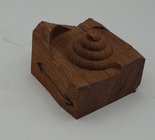
I'm not sure how we can make a comparison. With a finger nail test there is no noticeable difference in the cut quality 360 degrees around the cut area. Also the radii are all exactly the same. As I see it, good cut quality, crisp detail with accuracy.
Do you consider bubinga a difficult wood? I don't know. Maybe you could suggest a wood?
And clarify what we want to compare.... I think it should be unsanded cut quality.

odie
TOTW Team
- Joined
- Dec 22, 2006
- Messages
- 7,116
- Likes
- 9,830
Definitely has the look of CNC, and might even have been done on a lathe, slow turned......but the cutter impression has the look of a high speed cutter.....like a router, or shaper bit......a whole different process than something turned on a lathe in a more traditional fashion.Here's a quick one I found in my desk drawer. Bubinga with cross grain cutting. No sanding whatsoever. This was done awhile ago with no intention of achieving the best possible finish. The picture doesn't show the slight burnished finish. The blank is 2" square.
I'm not sure how we can make a comparison. With a finger nail test there is no noticeable difference in the cut quality 360 degrees around the cut area. Also the radii are all exactly the same. As I see it, good cut quality, crisp detail with accuracy.
Do you consider bubinga a difficult wood? I don't know. Maybe you could suggest a wood?
And clarify what we want to compare.... I think it should be unsanded cut quality.
View attachment 46234
-----odie-----
Here's rosewood base for a department store jewelry display (yes, occasionally I did production runs). No sanding, just as it came off the lathe.. The customer buffed it with some type of wax to give it what they called an antique finish. Note the left side no indication of tool or sanding marks.
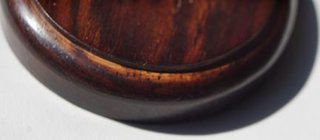
BTW, Odie, you made the challenge and to my knowledge you have never posted any of your as-turned work prior to sanding for a comparison to my work.

BTW, Odie, you made the challenge and to my knowledge you have never posted any of your as-turned work prior to sanding for a comparison to my work.
odie
TOTW Team
- Joined
- Dec 22, 2006
- Messages
- 7,116
- Likes
- 9,830
BTW, Odie, you made the challenge and to my knowledge you have never posted any of your as-turned work prior to sanding for a comparison to my work.
Doug......
Show us some lathe turned CNC......where the wood spins, and not the cutter. If you can do some intricate work in that manner......that's what we're discussing here. Looks to me like any details you're capable of, is the result of the shape of the blades on a high speed router, or shaper bit.....and, not the result of manipulating a stationary cutting edge against spinning wood.
-----odie-----
Last edited:

